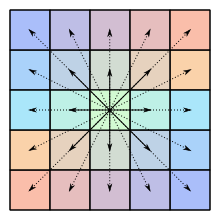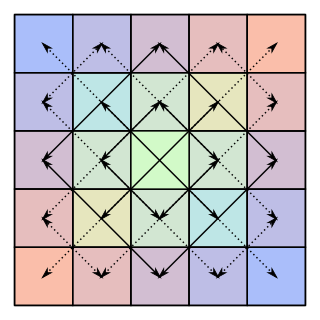
In mathematics, especially in linear algebra and matrix theory, a centrosymmetric matrix is a matrix which is symmetric about its center.

In mathematics, especially in linear algebra and matrix theory, a centrosymmetric matrix is a matrix which is symmetric about its center.
An n × n matrix A = [Ai, j] is centrosymmetric when its entries satisfy
Alternatively, if J denotes the n × n exchange matrix with 1 on the antidiagonal and 0 elsewhere:
then a matrix A is centrosymmetric if and only if AJ = JA.
An n × n matrix A is said to be skew-centrosymmetric if its entries satisfy
Equivalently, A is skew-centrosymmetric if AJ = −JA, where J is the exchange matrix defined previously.
The centrosymmetric relation AJ = JA lends itself to a natural generalization, where J is replaced with an involutory matrix K (i.e., K2 = I ) [2] [3] [4] or, more generally, a matrix K satisfying Km = I for an integer m > 1. [1] The inverse problem for the commutation relation AK = KA of identifying all involutory K that commute with a fixed matrix A has also been studied. [1]
Symmetric centrosymmetric matrices are sometimes called bisymmetric matrices. When the ground field is the real numbers, it has been shown that bisymmetric matrices are precisely those symmetric matrices whose eigenvalues remain the same aside from possible sign changes following pre- or post-multiplication by the exchange matrix. [3] A similar result holds for Hermitian centrosymmetric and skew-centrosymmetric matrices. [5]

In linear algebra, a symmetric matrix is a square matrix that is equal to its transpose. Formally,

In mathematics, a square matrix is a matrix with the same number of rows and columns. An n-by-n matrix is known as a square matrix of order . Any two square matrices of the same order can be added and multiplied.
In mathematics, a complex square matrix A is normal if it commutes with its conjugate transpose A*:

In linear algebra, the transpose of a matrix is an operator which flips a matrix over its diagonal; that is, it switches the row and column indices of the matrix A by producing another matrix, often denoted by AT.
In mathematics, particularly in linear algebra, a skew-symmetricmatrix is a square matrix whose transpose equals its negative. That is, it satisfies the condition
In linear algebra, a diagonal matrix is a matrix in which the entries outside the main diagonal are all zero; the term usually refers to square matrices. Elements of the main diagonal can either be zero or nonzero. An example of a 2×2 diagonal matrix is , while an example of a 3×3 diagonal matrix is. An identity matrix of any size, or any multiple of it is a diagonal matrix called scalar matrix, for example, . In geometry, a diagonal matrix may be used as a scaling matrix, since matrix multiplication with it results in changing scale (size) and possibly also shape; only a scalar matrix results in uniform change in scale.
In mathematics, a Hermitian matrix is a complex square matrix that is equal to its own conjugate transpose—that is, the element in the i-th row and j-th column is equal to the complex conjugate of the element in the j-th row and i-th column, for all indices i and j:
In linear algebra, a square matrix is called diagonalizable or non-defective if it is similar to a diagonal matrix. That is, if there exists an invertible matrix and a diagonal matrix such that . This is equivalent to . This property exists for any linear map: for a finite-dimensional vector space , a linear map is called diagonalizable if there exists an ordered basis of consisting of eigenvectors of . These definitions are equivalent: if has a matrix representation as above, then the column vectors of form a basis consisting of eigenvectors of , and the diagonal entries of are the corresponding eigenvalues of ; with respect to this eigenvector basis, is represented by .
In the mathematical discipline of linear algebra, a matrix decomposition or matrix factorization is a factorization of a matrix into a product of matrices. There are many different matrix decompositions; each finds use among a particular class of problems.
In the mathematical discipline of linear algebra, the Schur decomposition or Schur triangulation, named after Issai Schur, is a matrix decomposition. It allows one to write an arbitrary complex square matrix as unitarily equivalent to an upper triangular matrix whose diagonal elements are the eigenvalues of the original matrix.
In mathematics, a triangular matrix is a special kind of square matrix. A square matrix is called lower triangular if all the entries above the main diagonal are zero. Similarly, a square matrix is called upper triangular if all the entries below the main diagonal are zero.
In linear algebra, a Hankel matrix, named after Hermann Hankel, is a square matrix in which each ascending skew-diagonal from left to right is constant. For example,
In linear algebra, a square matrix with complex entries is said to be skew-Hermitian or anti-Hermitian if its conjugate transpose is the negative of the original matrix. That is, the matrix is skew-Hermitian if it satisfies the relation
In numerical analysis, one of the most important problems is designing efficient and stable algorithms for finding the eigenvalues of a matrix. These eigenvalue algorithms may also find eigenvectors.
In linear algebra, it is often important to know which vectors have their directions unchanged by a given linear transformation. An eigenvector or characteristic vector is such a vector. Thus an eigenvector of a linear transformation is scaled by a constant factor when the linear transformation is applied to it: . The corresponding eigenvalue, characteristic value, or characteristic root is the multiplying factor .
In linear algebra, a defective matrix is a square matrix that does not have a complete basis of eigenvectors, and is therefore not diagonalizable. In particular, an matrix is defective if and only if it does not have linearly independent eigenvectors. A complete basis is formed by augmenting the eigenvectors with generalized eigenvectors, which are necessary for solving defective systems of ordinary differential equations and other problems.
In mathematics, an involutory matrix is a square matrix that is its own inverse. That is, multiplication by the matrix A is an involution if and only if A2 = I, where I is the n × n identity matrix. Involutory matrices are all square roots of the identity matrix. This is simply a consequence of the fact that any invertible matrix multiplied by its inverse is the identity.
In linear algebra, eigendecomposition is the factorization of a matrix into a canonical form, whereby the matrix is represented in terms of its eigenvalues and eigenvectors. Only diagonalizable matrices can be factorized in this way. When the matrix being factorized is a normal or real symmetric matrix, the decomposition is called "spectral decomposition", derived from the spectral theorem.

In mathematics, a bisymmetric matrix is a square matrix that is symmetric about both of its main diagonals. More precisely, an n × n matrix A is bisymmetric if it satisfies both A = AT, and AJ = JA, where J is the n × n exchange matrix.
In linear algebra, two matrices and are said to commute if , or equivalently if their commutator is zero. A set of matrices is said to commute if they commute pairwise, meaning that every pair of matrices in the set commute with each other.